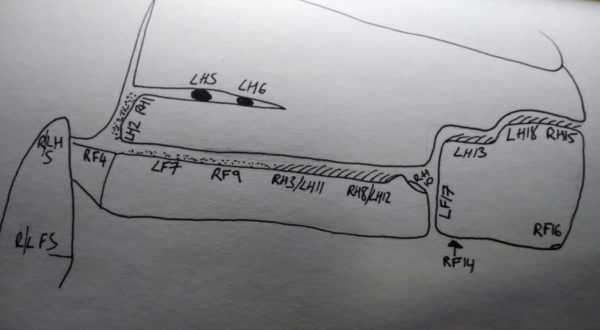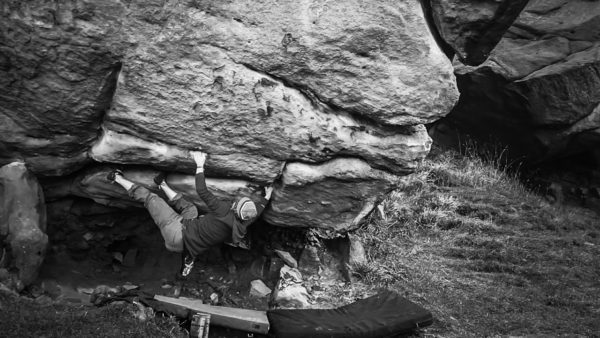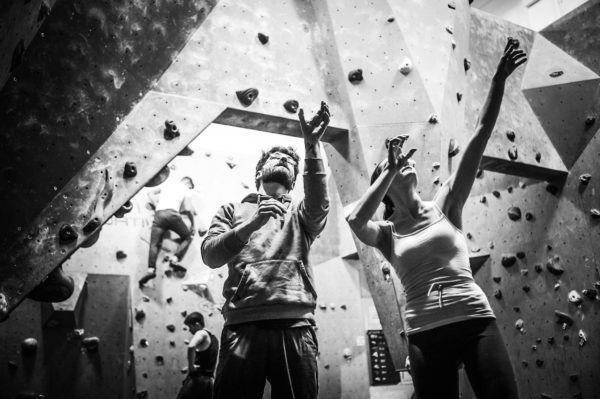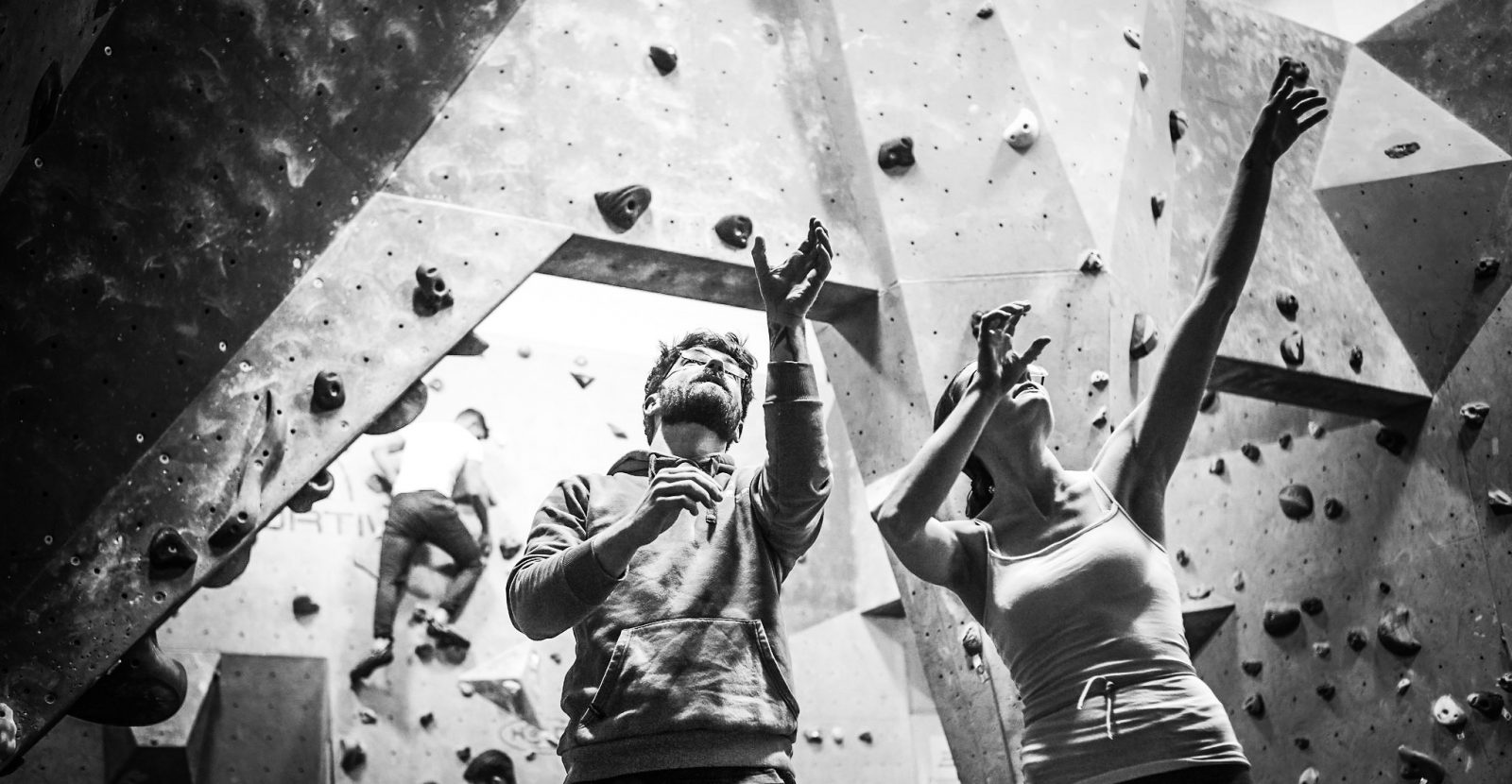How many of us are guilty of jumping straight onto a climb without looking at it first, only to fall off and notice a foot hold you missed? This is why route reading is so important. If you are aware of the holds before you set off and ideally some of the moves, you can save time on a climb. Less time on the wall, means less time on your arms while they are getting tired. Route reading is particularly important for flash or onsight climbing. A flash, is climbing a route or problem first attempt, after watching someone else climbing it. Onsight is climbing a route or problem first time, without any prior knowledge of the climb. All you have is what you can see from the ground. There in lies the first part of route reading… What you can see… Observation.
Look for hand and foot holds. Once you have identified all the possible holds, you can try to plan the moves too. I have heard a lot of people say, “I just can’t see the moves from the ground”. If this is you, I would suggest watching other climbers climb, especially good climbers. See how they move. Just watching people climb helps you start to picture it yourself. Watch carefully. Sometimes the difference between pulling a move or falling can be having your foot at one side of a hold or the other. I know I really used to struggle with predicting moves, until I started instructing climbing and watching others climb. This is also a really good excuse to watch lots of climbing films. Listen to how they describe a move too. Knowing the best bit of a hold or a direction of pressure (that you can’t see from the ground), may make all the difference.
Don’t worry if you have a few different ideas for a move and aren’t sure which to use. That’s great… you have options. There are often many different ways to do a move and you can just try whichever feels best when you get there. As well as looking at the moves you can also plan your rest positions and if you are lead climbing, where the good clipping positions are. Where are they in relation to the crux (the hardest moves on the climb)?
So, back to the start… Before you think about the moves you need to look at the climb. Identify all the holds. The next part is remembering them. Any memory games can help but being specific will be even better.
Exercise:
You will need something to time yourself with, some paper, a pencil and some pebbles or something similar (7-10 pebbles to start with).
First you need a climb to look at… This can be from a picture but another way to get a climb is to use the pebbles. They will be your holds. Drop them onto the floor. Where you are stood is the start and the furthest pebble away is the finishing hold. You will have to change the scale of this in your mind but it gives you a random set of holds to work with.
First time you drop the pebbles, give yourself 15 seconds to try and remember as much of the “problem” as you can. After 15 seconds, turn around and try to draw the problem. Once you have drawn the problem, turn back round and see how accurate you were. If you found it too easy then add more holds/pebbles and try again.
Drop the pebbles again, this time give yourself a full minute to try to remember the holds.
Did you remember it better this time? Remember… Take time before you climb.
If you missed some, or got the placements wrong, then here are some things to consider. People remember information in different ways. Some people remember better through visual cues, others verbal and others by movement. Find the combination that works for you. These techniques can be useful for onsight and flash climbing but also when working a project. A project is a difficult climb that you are unable to flash and have to work for multiple attempts.
Visual – Picture the climb in your mind. Draw the climb out. This can be particularly useful when projecting. It’s frustrating to work a move out one day and then return a few days later, only to have forgotten how to do the move. I have so many scraps of paper scattered throughout my guidebooks. You can make the shapes of the holds look like they do in real life or use a key. You can also label it with left hand, right hand, left foot, right foot and any other important notes for key movements.


Verbal – Talk through the moves. Use descriptive words for holds, they will stick in your memory better. I still remember the “brain hold” (amongst others) from working with one of the groups I coach. A lot of you can probably imagine which hold I’m talking about.
Movement – You will have all seen people at the bottom of climbs waving their arms about, “pantomiming” the route. This is brilliant as it gives you a feel for the movement and begins to build muscle memory. Remember not to forget foot holds.

You can practice drawing out your pebble problems, talking them through and pantomiming them. See which works best for you. Some of these, you may have been doing automatically the first time I asked you to remember the pebbles. As you get better, add more pebbles. For guidance routes at the wall generally have 25-30 holds and outdoor sports climbs are often 40 moves or more.
When actually climbing keep an eye out for any holds you may have missed from the ground, route setters like hiding holds around volumes and corners. One more piece of advice… Sometimes you will get on a climb and the move you planned is nothing like the move you think you should do when you are there… Don’t be afraid to try something different. I remember this route I was climbing in El Chorro. I worked out the moves to the crux section from the ground, but when it came to climbing it I spotted a poor smear. I thought about using it but I stuck with my plan and fell off the move. Tried that move multiple times… it felt so hard. I then tried the move I had intuitively wanted to make. It felt so much easier. So, although route reading is great… Go with your gut, as your intuition can quite often be correct.
Blog written by Vicky Jennings HCC Duty Manager & Coach
